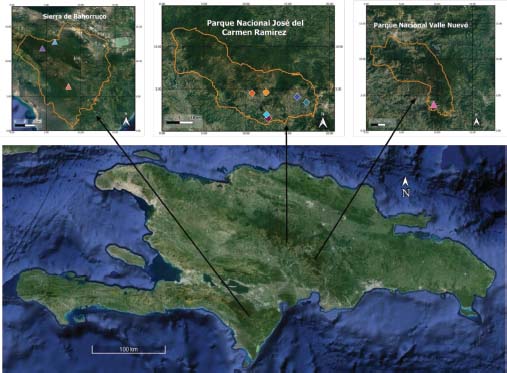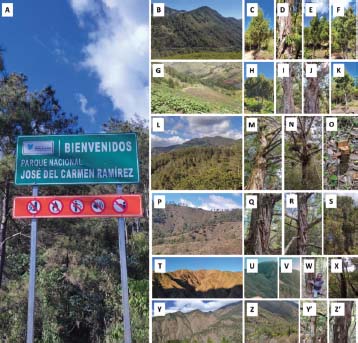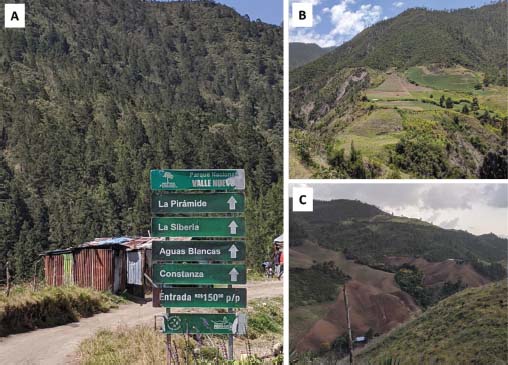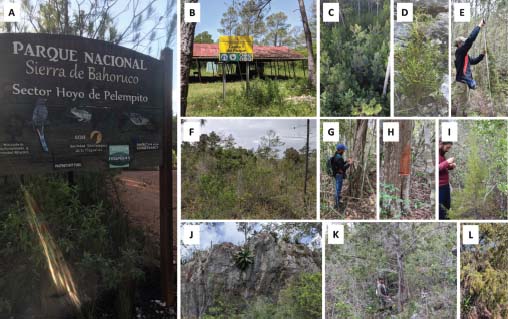Ciencia, Ambiente y Clima, Vol. 7, No. 1, enero-junio, 2024 ISSN (impreso): 2636-2317 • ISSN (en línea): 2636-2333 • Sitio web: https://revistas.intec.edu.do/
POPULATION REMNANTS OF JUNIPERUS GRACILIOR VAR. GRACILIOR PILG. (CUPRESSACEAE) IN THE DOMINICAN REPUBLIC
Remanentes poblacionales de Juniperus gracilior var. gracilior Pilg. (Cupressaceae) en la República Dominicana
ARIDIO DELGADO AYBAR1
ELÍ MISAEL BOBADILLA-PEÑALÓ2
LUIS ENRIQUE RODRÍGUEZ-DE FRANCISCO3
Recibido: 16 de mayo 2024 • Aceptado: 24 de mayo 2024
Cómo citar: Delgado Aybar, A., Boardilla-Peñaló, E. M. y Rodríguez-De Francisco, L. E. (2024). Population remnants of Juniperus gracilior var. gracilior Pilg. (Cupressaceae) in the Dominican Republic. Ciencia, Ambiente y Clima, 7(1), 85-98. https://doi.org/10.22206/cac.2024.v7i1.3154
Abstract
The natural remnants of populations of Juniperus gracilior var. gracilior, an endemic forest variety of the island that despite being in an important category of threat, its current conservation status is unknown. The research has been oriented in the study of the distribution and population structure of the relicts of this variety gracilior identifying, through field explorations in the main mountain systems of the country, the abundance of the taxon by locality, altitude, state of development, phytosanitary status in each individual. Based on the results presented, a re-evaluation of the variety’s threat level and the development of new programs for the rescue, regeneration, conservation and sustainable use of the taxon are considered urgent.
Keywords: abundance, population structure, development status, phytosanitary status, DBH.
Resumen
Se estudian los remanentes naturales de poblaciones de Juniperus gracilior var. gracilior, una variedad forestal endémica de la isla que pese a estar en una importante categoría de amenaza se desconoce su estado de conservación actual. La investigación se ha orientado en el estudio de la distribución y estructura poblacional de los relictos de esta variedad gracilior identificando, a través de exploraciones de campos en los principales sistemas montañosos del país, la abundancia del taxón por localidad, altura, estado de desarrollo, estado fitosanitario en cada individuo. A partir de los resultados que se presentan se considera urgente una reevaluación del nivel de amenaza de la variedad, la elaboración de nuevos programas de rescate, regeneración, conservación y aprovechamiento sostenible del taxón.
Palabras clave: abundancia, estructura poblacional, estado de desarrollo, estado fitosanitario, DAP.
Introduction
Juniperus gracilior Pilg (Cupressaceae) is an endemic species of the island of Hispaniola (Dominican Republic and Haiti) (Adams, 2014). This species is distinguished into three infraspecific varieties: J. gracilior var. gracilior, J. gracilior var. ekmanii, and J. gracilior var. urbaniana. Each of these varieties, with restricted geographical distributions, has experienced an alarming population decline, leading them to be classified in conservation threat categories.
J. gracilior var. gracilior is restricted to specific areas on the southern slope of the Cordillera Central, as well as in the Bahoruco and Martín García Sierras (Zanoni & Mejía, 1989). The latest population estimates for the three varieties of J. gracilior indicate the existence of fewer than 1,000 individuals in natural remnants, underscoring the critical conservation status of the species, considering its long regeneration period of approximately 30 years (Farjon, 2013).
The survival of J. gracilior var. gracilior is primarily threatened by various natural and anthropogenic factors such as forest fires, unsustainable logging, and the conversion of native forests for agricultural use (Adams, 1983; Peguero & Clase, 2015), mainly driven by the expansion of the agricultural frontier and the establishment of rural human settlements without adequate land-use planning. Consequently, the species has been categorized as Endangered (B2ab(ii,iii,iv,v)) by the International Union for Conservation of Nature (IUCN) (Farjon, 2013) and as Critically Endangered (CR A2acd+4acd; B2ab(i,ii,iii,iv,v)) on the Red List of Vascular Flora of the Dominican Republic, (García et al., 2016), reflecting the urgent need for conservation actions.
The scarcity of studies addressing the threats, distribution, ecology, and especially the status of the remaining populations of J. gracilior var. gracilior has severely limited the opportunities to implement effective conservation strategies. In this work, we present an overview of the current situation of all known population remnants of this species in the Dominican Republic. We have identified its exact geographical distribution, population composition and structure, as well as information related to the phytosanitary status of the evaluated individuals.
Materials and Methods
The study area was determined through explorations in mountainous systems conducted by park rangers, explorers, researchers, and through consultation of scientific literature. For these purposes, three major macroareas where J. gracilior var. gracilior had been reported were defined: the southern slope of the Cordillera Central (including Juan Bautista Pérez Rancier “Valle Nuevo” and José del Carmen Ramírez National Parks), the Sierra de Bahoruco, and the Sierra Martín García. Each of these zones was subdivided into specific localities, referring to the places where the endemic variety was found within each mountainous system, except for the Sierra Martín García where access to the localities was not possible.
Figure 1
Distribution map of the study areas in the Cordillera Central (José del Carmen Ramírez and Valle Nuevo National Parks) and Sierra de Bahoruco

In each of the identified localities, the area was georeferenced using a GPS MAP 64 x - GARMIN. A total census of the number of individuals in each population remnant was conducted. The total height was measured using a Suunto PM-5 clinometer, with a variable measurement distance (15-30 m) considering the distance at which the base and crown of the individual or a reference point could be seen (Zobrist, 2008). The diameter at breast height (DBH), at 1.30 m from the base, was measured using a measuring tape (Condit, 1998; FAO, 2004). The development stage of the population remnants, according to DBH, was classified into the following diameter categories: Seedling (50 cm) (Aguilar-Luna, 2018).
Notes were made on the phytosanitary status of the individuals considering the following criteria: 1. Healthy: if the individual showed normal development, trunk, stem, and crown with no signs of disease; 2. Diseased: if the individual showed significant signs of disease or physiological irregularity in any of its structures; 3. Dead: if no foliar structures, bark, or any signs of photosynthetic activity were observed.
Results
Population remnants were recorded in the mountainous systems of José del Carmen Ramírez National Park (Figure 2), Valle Nuevo National Park (Figure 3), and Sierra de Bahoruco (Figure 4). Within each of these areas, natural population remnants were identified, ranging in size from fewer than ten individuals to more than 60 (see Table 1).
Figure 2
Localities in José del Carmen Ramírez National Park. B) Entrance to Sabina del Sur: Located along the Constanza-El Tetero road; the individuals here, mostly juveniles (D, E, F), are situated on the south side of the road (C). G) Sabina del Sur: An area disturbed by agricultural and livestock activities; juvenile (H-K) and adult (I-J) Juniperus individuals are found within agricultural plots and grazing fences. L) La Caseta: The individuals are located within a forest patch composed of Pinus and shrubs; most individuals are sizable adults (M-N), and juvenile trunks were identified as having been cut down (O). P) Loma de Enmedio: The Juniperus population is on the southern slope of a grazing farm; all individuals are adults notable for their size and the light green color of their crowns (Q, R, S). T) Junta de Los Ríos: An area severely disturbed by anthropogenic activities; the individuals are located approximately 8 km north of the Palomino Dam, on the riverbank of the white canyon, and in mountainous remnants (U-V) that have not been affected by forest fires. The individuals are irregularly distributed among the wooded slopes. This locality recorded the tallest individuals with the largest DBH (X-W). Y) Manaclita: An area dedicated to grazing and agricultural activities; the populations are irregularly distributed near the northern bank of the Cañón Prieto River source (Z), with a large number of juvenile individuals (Y’) and some representative-sized adults (Z’)

Figure 3
A) Valle Nuevo National Park. B-C) The locality of Las Espinas, located in the buffer zone on the southern slope of the national park, where individuals of J. gracilior var. gracilior are found, distributed in an isolated manner. This area is influenced by anthropogenic activities, primarily agriculture, including the cultivation of vegetables, beans, and other crops

Figure 4
A) Sierra de Bahoruco National Park. B) Puerto Escondido, the Juniperus gracilior var. gracilior population consists of juvenile individuals interspersed among patches of Pinus (C), distributed in a specific area on rocky terrain with a significant slope. Near this locality is Saban Peblike, an extensive savanna where individuals of Juniperus gracilior var. urbaniana are found (E). F) The Cordillera del Hoyo de Pelempito, the population is isolated and irregularly distributed on a rocky formation along the southeastern edge of the Cordillera del Hoyo de Pelempito, with individuals generally being juveniles (H) and adults of medium height (G). I) La Isla del Zaboká, an area covered by shrubs with few adult trees, where Juniperus individuals are found in small clusters, some of which are dry adults (J) showing signs of human disturbance (K), in addition to individuals in the seedling stage (L)

Table 1
Localities with population remnants of J. gracilior var. gracilior
No. |
Protected Area |
Locality |
Coordinates |
Altitude (masl) |
1 |
Parque Nacional José del Carmen Ramírez |
La Entrada de la Sabina del Sur |
18.92193502, -70.816833 |
1,430 |
2 |
La Sabina del Sur |
18.94341398, -70.85034502 |
1,188 |
|
3 |
La Caseta |
18.87994898, -70.97638403 |
1,382 |
|
4 |
Loma de Enmedio |
18.87886201, -70.96094901 |
1,239 |
|
5 |
Parque Nacional Valle Nuevo |
Junta de los Ríos |
18.95712996, -71.01637099 |
1,303 |
6 |
Manaclita |
18.96543, -70.961924 |
1,293 |
|
7 |
Las Espinas |
18.68667997, -70.62170103 |
1,810 |
|
8 |
Parque Nacional Sierra de Bahoruco |
Puerto Escondido |
18.28364303, -71.56571598 |
1,019 |
9 |
La Cordillera del Hoyo de Pelempito |
18.07389102, -71.500444 |
1,180 |
|
10 |
La Isla del Zaboká |
18.06208201, -71.50197999 |
1,186 |
During the field explorations, a total of 211 individuals were found distributed along an altitudinal gradient from 1,021 to 2,026 meters above sea level. Generally, individuals were most abundant between 1,164 and 1,452 meters above sea level, with approximately 191 individuals, representing 90.5% of the total. In the Cordillera Central, 76.3% of the individuals were recorded, distributed between José del Carmen Ramírez National Park (73.9%) and Valle Nuevo National Park (2.36%).
Individuals studied in the different localities exhibited an average height of 10.9 meters, with values ranging from 1 to 27 meters, depending on the development stage and area. Most individuals recorded heights between 6 and 14 meters, while a few individuals were below 6 meters and above 16 meters. Only a small number of individuals exceeded 22 meters, with one dead individual reaching 27 meters, representing the maximum height (see Table 2).
Table 2
Development stages in populations remnants of J. gracilior var. gracilior
Locality |
Development Stage |
||||
Seedling |
Juvenile |
Young Tree |
Mature Tree |
Overmature Tree |
|
SB: Puerto Escondido |
- |
55,50% |
44,50% |
- |
- |
SB: La Isla de Zaboká |
9% |
30,40% |
56,60% |
4% |
- |
SB: Cordillera del Hoyo de Pelempito |
- |
55,60% |
44,40% |
- |
- |
PNVN: Las Espinas |
- |
40,00% |
- |
60% |
- |
PNJCR: Entrada de la Sabina del Sur |
83% |
17,00% |
- |
- |
- |
PNJCR: La Sabina del Sur |
15% |
38,40% |
46,10% |
- |
- |
PNJCR: La Caseta |
37% |
16,60% |
30,00% |
17% |
- |
PNJCR: Junta de Los Ríos |
- |
- |
31,80% |
55% |
14% |
PNJCR: Loma de en Medio |
- |
- |
81,80% |
18% |
- |
PNJCR: Manaclita |
- |
4,70% |
73,00% |
22% |
- |
Regarding the development stage, slightly more than half of the individuals are grouped in the Young Tree category. Only 9.4% of the individuals are in the Seedling stage and 18% in the Juvenile stage, the latter two categories comprising the youngest individuals, indicative of the apparent low regeneration rate of J. gracilior var. gracilior (see Table 2).
The individuals with the highest average height and DBH are found in Junta de Los Ríos, the only locality with individuals in the Overmature Tree stage. These growth values are likely due to the difficult access to the locality for timber extraction and the presence of forest relics that, in addition to favorable ecological conditions, have not been directly impacted by forest fires. These areas also had significant vegetative cover with an understory mainly composed of Pinus occidentalis and other large trees with broad crowns, such as Cedrela odorata, Ekmanianthe longiflora, Swietenia mahagoni, Tetragastris balsamifera, among others. Other localities, such as Loma de Enmedio and La Caseta, also have individuals of notable size, probably due to their proximity to entities dedicated to park protection.
However, in the localities of Junta de Los Ríos, Loma de Enmedio, and to a lesser extent, Manaclita, the low proportion of individuals in the Seedling and Young Tree stages stands out, indicating an almost null regeneration rate, which raises concerns about the perpetuity of the taxon in these areas. Thus, it is crucial to study factors such as flowering, fruiting, germination, and potential predation events on reproductive structures by animals or fungal species.
The populations of J. gracilior var. gracilior analyzed in this study exhibit good phytosanitary conditions (see Table 3). Two hundred of the 211 individuals (94.7%) display healthy physiological characteristics, with no signs of diseases in any of their visible anatomical structures, reflecting lime green foliage, branches, stems, and trunks without signs of attacks or structural deformities. Only two (0.94%) of the sampled individuals showed signs that could be linked to a plant pathology, such as intense foliage yellowing, dry branches, and bark peeling, among others. 4.2% of the individuals were dry or dead, showing no apparent signs of metabolic activity and lacking the main photosynthetic structures.
Table 3
Abundance, growth parameters and phytosanitary conditions
Locality |
Abundance |
Phytosanitary conditions |
DBH (cm) |
Height (m) |
||
Healthy |
Diseased |
Dead |
||||
SB: Puerto Escondido |
18 |
62% |
11,00% |
27% |
13.48 ± 4.20 |
15.2 ± 3.03 |
SB: La Isla de Zaboká |
23 |
96% |
- |
4% |
15.7 ± 8.24 |
14.8 ± 6.53 |
SB: Cordillera del Hoyo de Pelempito |
9 |
100% |
- |
- |
16.6 ± 7.43 |
9.4 ± 3.50 |
PNVN: Las Espinas |
5 |
100% |
- |
- |
27.3 ± 18.55 |
9.6 ± 1.51 |
PNJCR: Entrada de la Sabina del Sur |
6 |
100% |
- |
- |
4.1 ± 0.80 |
7.4 ± 3.87 |
PNJCR: La Sabina del Sur |
13 |
92% |
- |
8% |
11.8 ± 6.25 |
12.4 ± 4.93 |
PNJCR: La Caseta |
30 |
100% |
- |
- |
14.4 ± 13.47 |
7.4 ± 3.83 |
PNJCR: Junta de Los Ríos |
22 |
91% |
- |
9% |
35.5 ± 11.47 |
13.8 ± 3.18 |
PNJCR: Loma de en Medio |
22 |
100% |
- |
- |
25.2 ± 7.01 |
8.5 ± 1.85 |
PNJCR: Manaclita |
63 |
100% |
- |
- |
23.8 ± 7.92 |
10.1 ± 3.01 |
SB: Sierra de Bahoruco, PNVN: Parque Nacional Valle Nuevo, PNJCR: Parque Nacional José del Carmen Ramírez
Discussion
The IUCN Red List recognizes only two localities where J. gracilior var. gracilior had been recorded up to that date: in the La Vega province, near and 14 km west of Constanza, and in the Azua province, Valle del Yaque (Farjon, 2013). However, the results of this investigation identified 10 localities where the variety was found, including three localities in the Sierra de Bahoruco and at least four new localities in José del Carmen Ramírez National Park. Based on the height and DBH of the individuals recorded in the new reported localities, it can be established that these populations do not represent a recent expansion of the taxon, but rather had not been studied previously.
The IUCN also indicates that, due to the extent of occurrence and area of occupancy, the variety falls below the thresholds for an Endangered classification, with a continuous decline in mature individuals and a regeneration period of approximately 30 years. Furthermore, it is stated that "no specific information is available on population size" (Farjon, 2013). Therefore, an update of the information is suggested based on the data presented in this study.
All localities exhibited a low regeneration rate, especially in Valle Nuevo and the Sierra de Bahoruco, with only 9.4% of the individuals in the seedling stage. These figures suggest that, despite a possible decrease in anthropogenic exploitation of the variety in recent decades, it has been facing bioecological factors, possibly unknown until now, that significantly affect the taxon’s reproduction. Factors potentially influencing the low recruitment rate of J. gracilior var. gracilior may include low seed production in some localities, poor seed viability, and an almost negligible germination rate of these cones.
Although all localities where remnants of J. gracilior var. gracilior populations were found are within significant protected areas, most of them showed signs of at least one anthropogenic activity threatening the sustainable development of this and other forest species in these areas. A notable positive aspect for the taxon’s remnants is the favorable phytosanitary conditions exhibited by most individuals, suggesting that, at least apparently, there is no evidence of populations being affected by any significant phytopathology.
Although this research reports at least 7 new localities where remains of Juniperus gracilior var. gracilior, the representation of the taxon by only 211 individuals indicates a considerably low abundance, which added to the very low levels of regeneration and possible unfavorable bioecological factors affecting the reproduction and development of the variety suggest that the subspecies may need to be reclassified in a category that represents a higher threat level, such as Critically Endangered (CR).
Conclusions
Based on the total number of adult and juvenile individuals found and considering that all known locations of the subspecies in the studied mountainous systems were visited, it is evident that J. gracilior var. gracilior has suffered a severe population decline, with remnants reaching the highest levels of threat and risk of extinction. This situation urgently demands special attention from relevant authorities for its protection, study, and conservation. The Cordillera Central, specifically José del Carmen Ramírez National Park, is the mountainous system on the island with the greatest distribution and abundance of J. gracilior var. gracilior, representing the most important study area for the conservation of the subspecies. It contains the individuals with the largest diameter and the most extensive regenerative group of all the studied areas.
Acknowledgments
We would like to thank the National Fund for Innovation and Scientific and Technological Development (FONDOCYT) for supporting this project through the “Studies on Population Variability and Response to Stresses of the Genus Juniperus using a Multi-Omics Approach (Transcriptomics, Proteomics, and Metabolomics) 2016-2017-214” via the Deanery of Basic and Environmental Sciences of the Instituto Tecnológico de Santo Domingo.
Author Contributions
ADA, EBP, and LERdF designed the research concept, methodology, and instruments. ADA conducted the fieldwork. ADA and EBP analyzed the data and drafted the manuscript. All authors participated in the final review and discussion of the work.
References
Adams, R. P. (1983). The Junipers (Juniperus, Cupressaceae) of Hispaniola Comparison with other Caribbean species and among collections from Española. Moscosoa, 2(1), 77-89. https://acortar.link/XYGLgp
Adams, R. P. (2014). Junipers of the world: The genus Juniperus. Trafford Publishing. Indiana, United States of America. 422 p. https://acortar.link/BTzlDm
Aguilar Luna, J. M. (2018). Estructura y diversidad de la vegetación arbórea de un bosque de galería en el estado de Puebla. Revista Mexicana de Ciencias Forestales, 9(1), 230–252. 10.29298/rmcf.v9i47.154
Condit, R. (1998). Tropical Forest Census Plots: Methods and Results from Barro Colorado Island, Panama and a Comparison with Other Plots. Smithsonian Tropical Research Institute Panama. ISBN: 3-540-64144-0
Farjon, A. (2013). Juniperus gracilior. The IUCN Red List of Threatened Species: e.T42236A2965274. https://www.iucnredlist.org/es/species/32517/2821155
García, R., Peguero, B., Jiménez F. R., Veloz, A. y Clase, T. (2016). Lista roja de la flora vascular en República Dominicana. Jardín Botánico Nacional Dr. Rafael Ma. Moscoso; Ministerio de Medio Ambiente y Recursos Naturales; Ministerio de Educación Superior Ciencia y Tecnología (MESCyT). Santo Domingo. 763 p. https://bvearmb.do/handle/123456789/185
Organización de las Naciones Unidas para la Agricultura y la Alimentación [FAO]. (2004). Inventario forestal nacional. Programa de Evaluación de Los Recursos Forestales. Documento de Trabajo 94/S, 89. http://www.fao.org/3/ae578s/ae578s.pdf
Peguero, B. y Clase, T. (2015). Composición y estructura de la vegetación en Cerro Angola, San José de las Matas, provincia Santiago, República Dominicana. Moscosoa 19, 2015, 37-69. https://jbn.gob.do/transparencia/index.php/publicaciones-t/category/334-revista-moscosoa?download=442:moscosoa-volumen-19
Zanoni T. y Mejía, M. (1989). Notas sobre la flora de la isla Española III. Moscosoa, 5, 85-115. https://www.biodiversitylibrary.org/page/47223302#page/91/mode/1up
Zobrist, K. W. (2008). Virtual cruiser vest: measuring your forest stand. http://www.ruraltech.org/virtual_cruiser/resources/
_______________________________
1 Instituto Superior de Formación Docente Salomé Ureña (Isfodosu). Santo Domingo, República Dominicana. Universidad ISA. Grupo de Investigación Biodiversidad, Ecología y Conservación. Santiago, República Dominicana. Instituto Tecnológico de Santo Domingo (INTEC), Área de Ciencias Básicas y Ambientales. Santo Domingo, República Dominicana. ORCID: 0000-0002-0017-2035
2 Universidad ISA, Herbario Erik Leonard Ekman (ELE). Grupo de Investigación Biodiversidad, Ecología y Conservación. Santiago, República Dominicana. ORCID: 0000-0002-0725-9854. Correo-e: ebobadilla@isa.edu.do
3 Instituto Tecnológico de Santo Domingo (INTEC), Área de Ciencias Básicas y Ambientales. Santo Domingo, República Dominicana. ORCID: 0000-0001-9146-8634
